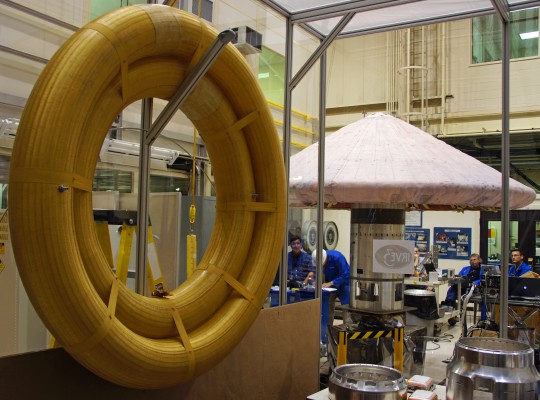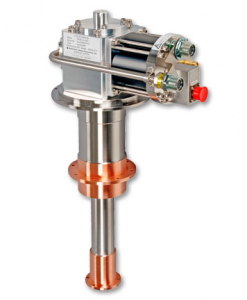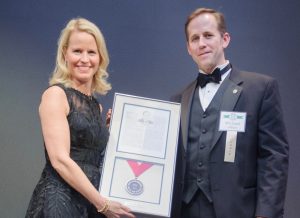Southern Research engineers conducted tests that advanced an experimental NASA technology designed to solve a tough challenge in landing people and cargo on Mars – slowing down a spacecraft entering the Red Planet’s thin atmosphere to permit a safe touchdown.
The Hypersonic Inflatable Aerodynamic Decelerator, or HIAD, is essentially a doughnut-shaped heat shield made of soft, flexible materials. The system is like a cone of inflatable inner tubes that’s packed tightly into a spacecraft and automatically deployed to use atmospheric drag to slow a fast-moving capsule during descent.

The innovative HIAD system is being examined for possible uses such as manned missions to Mars and landing cargo weighing more than 20 metric tons on other worlds.
“NASA was able to land the Mars Rover, but that is a pretty small device,” said Jacques Cuneo, a Southern Research engineer involved in the testing of HIAD’s materials. “If humans ever go to Mars, we will need to land many things with lots of mass – structures, supplies and other vital items.
“NASA will need to land large payloads, and, right now, they just can’t do it.”
When it comes to Mars, NASA’s mission planners must contend with an atmosphere that is roughly 100 times thinner than Earth’s and composed mostly of carbon dioxide, which can float to the planet’s frigid surface as snowflakes.
FOLDING TESTS
Southern Research’s assigned task in HIAD’s development centered on a key question posed by NASA’S Langley Research Center in Hampton, Virginia, according to Cuneo.
The HIAD’s inflatable structure is fashioned from a fastened series of pressurized concentric tubes, or tori, that form an exceptionally strong cone-shaped shield. The tori’s braided synthetic fibers are 15 times stronger than steel, according to NASA.
But would packing the inflatable aeroshell’s flexible materials into the tight confines of a spacecraft threaten the system’s performance and doom the mission?

“When they fold this complex item, when they crunch it down, there is no way for them to get a regular fold,” Cuneo said. “It’s going to end up crumpled, it’s going to have kinks. There is definite randomness in what happens.
“It’s not like a parachute where they nicely fold it up and pack it in every time,” he added. “After they fold HIAD up, they compress it, so there is going to be some damage. The question is whether it can withstand this damage.”
The Southern Research team designed an extensive series of tests to provide an answer.
The engineers conducted folding studies meant to generate a wide range of creases and folds in the flexible HIAD materials during the packing process. They then evaluated specimens of the materials in strength-retention and permeation tests.
“We were looking to see what kind of property retention it has and what kind of damage occurred while it was folded up,” Cuneo said. “We folded it up loosely, we folded it up tightly. We introduced a lot of different conditions to see how it was going to perform, and the material actually did really well.
“That gave NASA confidence that what they are doing makes sense, and that catastrophic damage was not going to result from the folding operation,” he added.
COMPRESSION TESTS
Last year, NASA put HIAD through a key field test. Engineers used a vacuum pump to compress a 9-foot diameter prototype of the inflatable heat shield into the tight confines of a spacecraft. They then checked the materials for leaks and damage.
After that successful test, NASA said its engineers will move forward with the development of a larger HIAD that can withstand the stress of being tightly packed in a rocket and the challenges experienced when it descends through the atmosphere of a planet such as Mars.

Cuneo said the innovative technology holds promise as NASA contends with the challenges of landing large volumes of supplies, scientific instruments and equipment on worlds with thin atmospheres.
“HIAD has an excellent shot at being utilized down the road for these types of missions,” he said. “It might be Mars or a moon of Jupiter. The technology is there to utilize.”
NASA PARTNERSHIP
Birmingham-based Southern Research has a long history of collaboration with NASA, dating back to the early days of the Apollo program. As part of that work, engineers analyzed the thermal and mechanical properties of potential shield materials and developed mathematical models to predict their performance in re-entry conditions.
Southern Research conducted similar work for the Space Shuttle program, while also remedying a potentially catastrophic rocket nozzle problem and helping the NASA “Return to Flight” missions after the Columbia accident.
Today, the organization is involved in the Space Launch System, or SLS, the massive rocket NASA is developing for planned Mars missions.
“The unique talents of Southern Research’s engineers have contributed to many of NASA’s most significant projects over the decades, and that’s continuing today as the space agency plans epic missions to land astronauts on Mars,” said Michael D. Johns, the organization’s vice president of Engineering.



